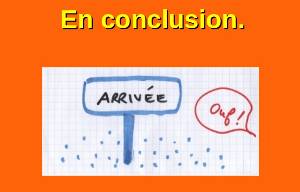
Please ensure you have JavaScript enabled in your browser. If you leave JavaScript disabled, you will only access a portion of the content we are providing. Here's how.
Key Info
Your conclusions summarize how your results support or contradict your original hypothesis:

The conclusion contains similar elements to the discussion, and sometimes these two sections are combined (especially in shorter papers and journal articles). But in a thesis or dissertation, it’s usual to include a final chapter that wraps up your research and gives the reader a final impression of your work. In a conclusion paragraph, you summarize what you’ve written about in your paper. When you’re writing a good conclusion paragraph, you need to think about the main point that you want to get across and be sure it’s included. If you’ve already written a fabulous introductory paragraph, you can write something similar with different wording. In composition, the term conclusion refers to the sentences or paragraphs that bring a speech, essay, report, or book to a satisfying and logical end. Also called the concluding paragraph or closing. The length of a conclusion is generally proportional to the length of the whole text.
- Summarize your science fair project results in a few sentences and use this summary to support your conclusion. Include key facts from your background research to help explain your results as needed.
- State whether your results support or contradict your hypothesis. (Engineering & programming projects should state whether they met their design criteria.)
- If appropriate, state the relationship between the independent and dependent variable.
- Summarize and evaluate your experimental procedure, making comments about its success and effectiveness.
- Suggest changes in the experimental procedure (or design) and/or possibilities for further study.
- A conclusion is a chance for you to relate with your audience, human to human. This is especially important if you’ve just finished writing an exhaustively detailed or complicated technical post. To help breathe at the end, make a few personal comments.
- Conclusions Conclusions wrap up what you have been discussing in your paper. After moving from general to specific information in the introduction and body paragraphs, your conclusion should begin pulling back into more general information that restates the main points of your argument.
Overview
Your conclusions will summarize whether or not your science fair project results support or contradict your original hypothesis. If you are doing an Engineering or Computer Science programming project, then you should state whether or not you met your design criteria. You may want to include key facts from your background research to help explain your results. Do your results suggest a relationship between the independent and dependent variable?
If Your Results Show that Your Hypothesis is False

If the results of your science experiment did not support your hypothesis, don't change or manipulate your results to fit your original hypothesis, simply explain why things did not go as expected. Professional scientists commonly find that results do not support their hypothesis, and they use those unexpected results as the first step in constructing a new hypothesis. If you think you need additional experimentation, describe what you think should happen next.

Scientific research is an ongoing process, and by discovering that your hypothesis is not true, you have already made huge advances in your learning that will lead you to ask more questions that lead to new experiments. Science fair judges do not care about whether you prove or disprove your hypothesis; they care how much you learned.
Conclusions Checklist
| What Makes for Good Conclusions? | For Good Conclusions, You Should Answer 'Yes' to Every Question |
| Do you summarize your results and use it to support the findings? | Yes / No |
| Do your conclusions state that you proved or disproved your hypothesis? (Engineering & programming projects should state whether they met their design criteria.) | Yes / No |
| If appropriate, do you state the relationship between the independent and dependent variable? | Yes / No |
| Do you summarize and evaluate your experimental procedure, making comments about its success and effectiveness? | Yes / No |
| Do you suggest changes in the experimental procedure and/or possibilities for further study? | Yes / No |
Explore Our Science Videos
Conclusion
DIY Toy Sailboat | Make A Tissue Paper Parachute - STEM Activity | Stretchy Balloons! Fun STEM Activity |

In a non-fictionbook, a conclusion is an ending section which states the concluding ideas and concepts of the preceding writing. This generally follows the body or perhaps an afterword, and the conclusion may be followed by an epilogue, outro, postscript, appendix/addendum, glossary, bibliography, index, errata, or a colophon. Aristotle, in The Rhetoric, tells us a good writer should do this in the conclusion: 'make the audience well-disposed towards ourselves and ill-disposed to our opponent.' It's a good opportunity to make inferences or predictions, or to ask the audience to consider what would happen if they do not accept our point of view by making a connection to society in general.
Conclusion Sentences
See also[edit]
Conclusion Transitions
References[edit]
Conclusion Words
